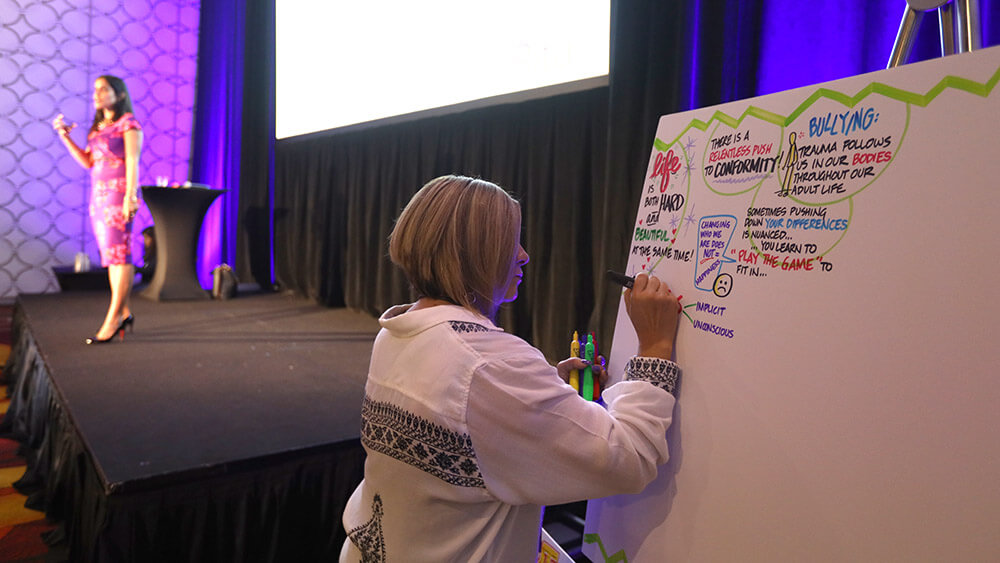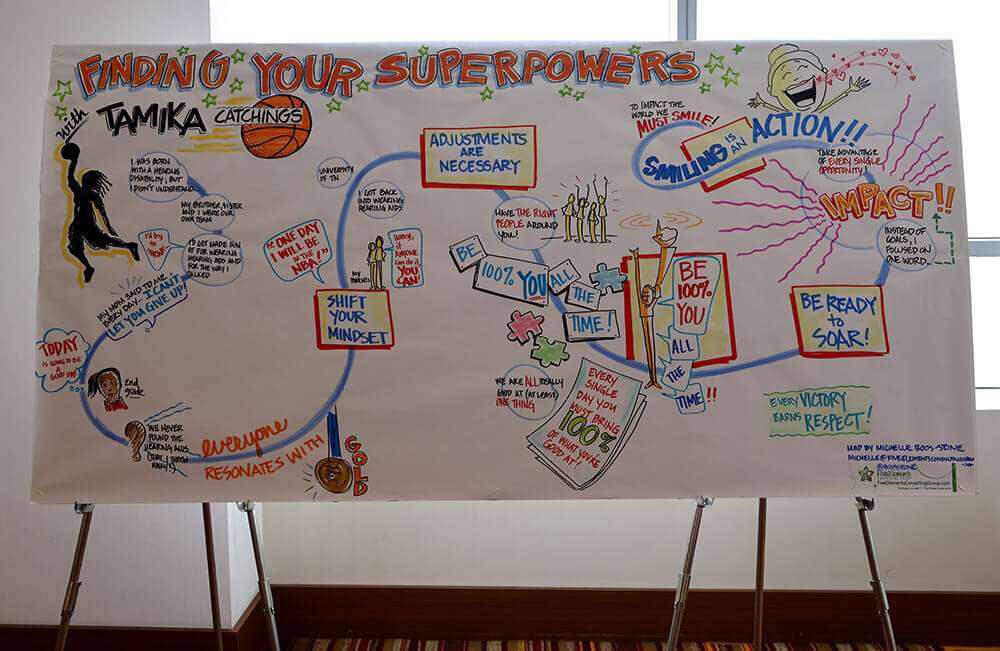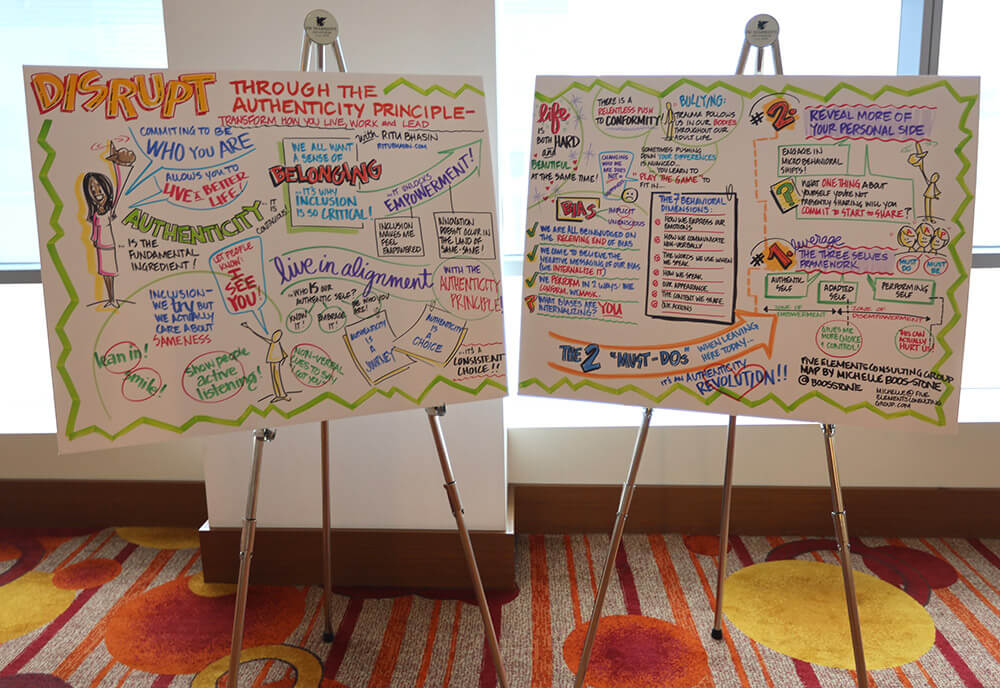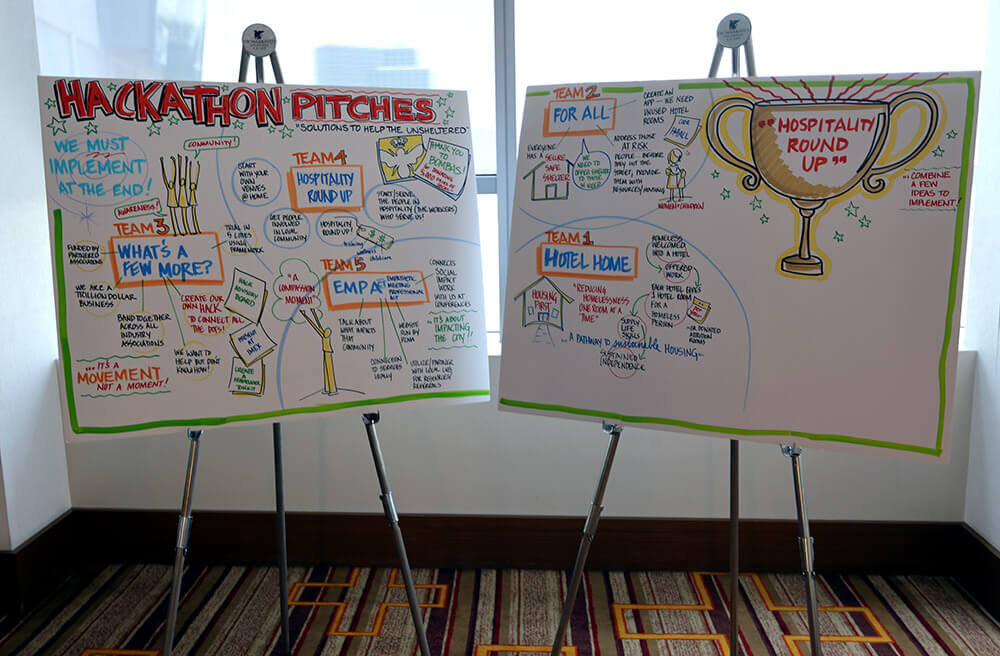
Michelle Boos-Stone of Five Elements Consulting Group interprets a session with her drawing at 2019 EduCon. (Jacob Slaton Photography)
At Convening Leaders 2019, attendees might have noticed artwork on poster boards lining some of the David L. Lawrence Convention Center’s corridors. The drawings, which illustrated concepts from various educational sessions, were the work of Michelle Boos-Stone as well as employees from her consulting firm, Five Elements Consulting Group.
Founded 23 years ago, Five Elements Consulting Group is made up of graphic recorders like Boos-Stone, as well as consultants, facilitators, and visual communicators, whose eye-grabbing visuals help organizations and attendees better retain information from meetings and events.
“Between 82 and 85 percent of people globally are primarily visual learners,” Boos-Stone, a business strategy and Culture Change consultant, speaker, and facilitator told Convene. “So when people hear something and they can see something, their retention rate goes up exponentially.”
Boos-Stone serves as a graphic recorder for more than 50 meetings and events each year and is at PCMA EduCon 2019 in Los Angeles this week to record as well as to teach an outdoor workshop on intentional leadership. At EduCon, where her work is being displayed on the third-floor skybridge at JW Marriott Los Angeles L.A. Live, she is bringing content to life and translating words into “amazing imagery,” PCMA Board of Directors Chair Gregory O’Dell said as the event kicked off on Wednesday. Ahead of EduCon, she shared with Convene the kind of imagery attendees respond to best and what her creative process looks like.

Michelle Boos-Stone of Five Elements Consulting Group captures the energy of Tamika Catchings on the Thursday Main Stage. (Jacob Slaton Photography)
Why do you think graphic recording resonates with attendees?
When someone is a visual learner, they can sit in on a session and that’s great — they can follow along with a PowerPoint. But if you then layer it with live graphics that are coming at them and they’re able to watch that, those images will actually imprint in their brain and they’ll be able to retain the information so much easier than if they were just listening to it.
Have you found that people respond better to certain colors?
Back in the 1990s, I was doing a lot of work in Asia and I was working with Coca-Cola, and their color is red. So I would write in red a lot until an ex-pat came up to me in a meeting and said, “You know, you can’t write in red here in China, because that’s how we break up with people. That’s the only time we ever write in red pen, is when we write them a [break-up] note in red ink.” So it has a very negative connotation, and I wondered, “What else am I doing wrong internationally, culturally, that doesn’t make sense color-wise?”
I actually went back to school and studied Color Theory — about how color affects people, and did all kinds of research on colors that stimulate people’s thinking. What kinds of colors can you use to kind of illicit a reaction from people? Now I have a very specific mix of colors that I use when I’m graphic recording. You can’t write in all black, for example. You want to use red as a highlight color only. Yellow irritates people. Green, for example, is a great color because it refers to life and longevity and the earth, but in some cultures, it’s not a color you would use there. So there’s all kinds of cultural implications and also in terms of how people react to visuals that are effective with the kinds of colors that you use. Blues are fantastic [internationally], like a light blue, a sky blue, and then a darker blue is great, too.

Ritu Bhasin’s vibrant Disrupt Through the Authenticity Principle – Transform How You Live, Work, and Lead session is featured on two panels. (Jacob Slaton Photography)
Are there certain images that people of different cultures respond to well?
I try to make sure that the images I use are as generic as possible in terms of the content. If I’m working with an international crowd, for example, I make sure that I’m using the simplest terminology on my board but also images that would be easily recognizable to people of all countries. And that the people are fairly generic and all different skin colors, so that everyone can kind of see themselves in the images and really be able to understand, even if English isn’t their first language. I want people to look at my map and say, “I get the general idea and the concept of what was taking place in that meeting or in that presentation.”
Do you have any idea what will happen in the session before it happens, or are you learning alongside the attendees?
I’m learning it right in the moment with the attendees. I actually prefer it that way, because then I’m not pigeon-holed into a space where I’ve already read something, then the speaker decides not to talk about it. I prefer to just be in the moment, listen to what is being said, and then to capture that in the moment. I don’t like to be tainted by a PowerPoint presentation ahead of time.
Sessions can move at a quick pace. How do you keep illustrating while still listening for key points the speaker may be discussing?
That’s actually one of the hardest things to teach people in graphic recording. It’s really a learned skill that you have to hone over many years of practice. To me now, it’s like breathing. But I have super great short-term memory where I can actually hold information and be writing and still listening to what’s happening in the moment.

As Hackathon teams pitched their solutions to unsheltered homelessness, Michelle Boos-Stone crystallized the high points. (Jacob Slaton Photography)
When you are recording a session, how do you decide what messages and key points to illustrate?
I think that I think about this differently than other graphic recorders do because I have a business background. If I weren’t a graphic recorder, I’d be sitting in the audience at one of these sessions. What I like to think about now, after doing this for so many years, is what are the people in the audience going to need to remember afterwards? Or what are they going to want to remember? As I’m listening to a speaker talk or a presentation go on, I’m sometimes hearing things when they have only spoken three paragraphs, but I’ve latched on — like I can kind of dig through all of that and say, “Bam! Those are the two sentences that are the most powerful” — and those are the two that I write down and draw a picture for.
You teach yourself to filter out the unnecessary. Because we talk in stories — a lot of people talk in stories. So you just filter out what is the most important and the big nugget, the big chunk, and pull those out. A lot of times a speaker will also say, “Here’s five things you need to do in order to be an effective leader,” and so I know I’m listening for five different chunks of information.
Casey Gale is a Convene associate editor.
